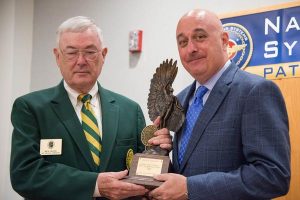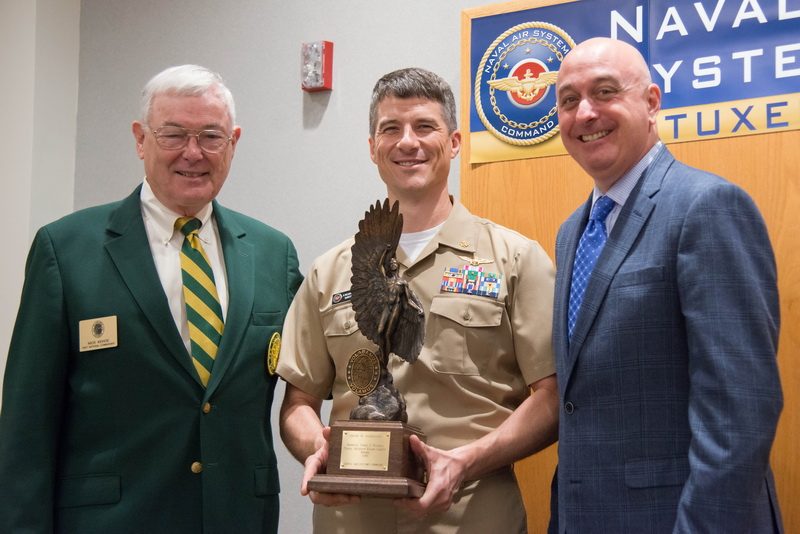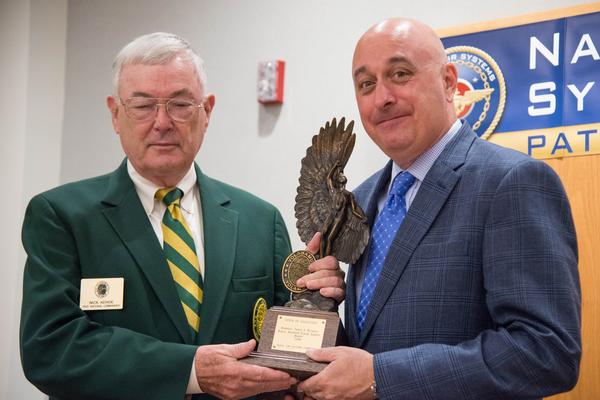 NAVAIR Assistant Commander for Corporate Operations and Total Force Stephen Cricchi accepted the 2016 Adm. James S. Russell Naval Aviation Flight Safety Award June 15 during a modest conference room ceremony.
NAVAIR Assistant Commander for Corporate Operations and Total Force Stephen Cricchi accepted the 2016 Adm. James S. Russell Naval Aviation Flight Safety Award June 15 during a modest conference room ceremony.
The award, which Cricchi accepted on behalf of NAVAIR Commander Vice Adm. Paul Grosklags, was one of two top naval aviation safety awards NAVAIR has won for its outstanding 2016 safety record and ongoing contributions to readiness and efficient operations. This is the sixth time NAVAIR has won the award.
The Russell award is granted automatically to the recipient of the second award, the the Naval Aviation Readiness Through Safety Award. The two awards were announced by the Naval Safety Center in October.
“NAVAIR’s 28,000 employees are dedicated to providing Sailors and Marines with aircraft and related systems that are safe to operate, often under very challenging operational conditions,” Grosklags said.
“I’m proud that our safety team and the NAVAIR units which conduct flight operations set that same high standard for our own operations, which typically focus on testing of new or post-major maintenance aircraft and systems.”
On hand for the June 15 ceremony was retired Lt. Gen .Nick Kehoe of the Order of Daedalians, a fraternal organization of American military pilots that presents the award annually to the command that contributed the most toward readiness and economy of operations through safety during the fiscal year.
To win, a command must have an outstanding safety record and an aggressive safety program, showcasing an improving safety trend over the previous three years and low rates of Class A and Class B mishaps.
During fiscal year 2016, NAVAIR recorded more than 21,000 flight hours with no Class A or B flight, flight-related or aviation ground mishaps, making it the best among its competition for the awards.
The command is responsible for the flight operations of Naval Air Warfare Center Aircraft and Weapons Divisions and the Fleet Readiness Centers (FRCs), among other aviation units.
A Class A mishap is one that results in more than $2 million in damage, the destruction of a Department of Defense aircraft, or a fatality or permanent total disability. A Class B mishap is one that results in between $500,000 and $2 million in damage, a permanent partial disability, or the hospitalization of three or more personnel.
“These awards are a testament to the people of NAVAIR and their commitment to our aviation safety management system,” said Lt. Cmdr. P. Elliott Porter Jr., NAVAIR aviation safety director.
“There’s an excellent safety culture in NAVAIR,” he continued. “People look out for one another and are encouraged to freely voice their concerns. Leadership is critical. Because leadership allows people to raise issues freely, it opens the aperture and increases the probability hazards will be identified and controlled.”
Historically, about 80 percent of mishaps are due to a lack of procedural compliance, or human error “where someone didn’t do something they were supposed to do,” Porter said. “I think these awards are reflective of the commitment by the people here at NAVAIR to brief what they fly and fly what they brief.”

Retired Lt. Gen .Nick Kehoe from the Order of Daedalians (left), Lt. Cmdr. P. Elliott Porter Jr., Naval Air Systems Command aviation safety director (center), and Stephen Cricchi, NAVAIR assistant commander for Corporate Operations and Total Force (right) pose with the 2016 Adm. James S. Russell Naval Aviation Flight Safety Award. Cricchi accepted the award June 15 on behalf of NAVAIR Commander Vice Adm. Paul Grosklags. The Order of Daedalians presented the award in recognition of NAVAIR’s exceptional safety record. (U.S. Navy photo)


Retired Lt. Gen. Nick Kehoe of the Order of Daedalians presents the 2016 Adm. James S. Russell Naval Aviation Flight Safety Award to Stephen Cricchi, Naval Air Systems Command assistant commander for Corporate Operations and Total Force on June 15 in recognition of NAVAIR’s exceptional safety record. Cricchi accepted the award on behalf of NAVAIR Commander Vice Adm. Paul Grosklags. (U.S. Navy photo)


